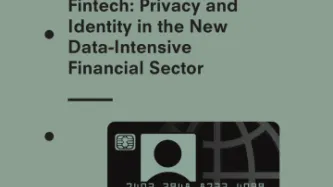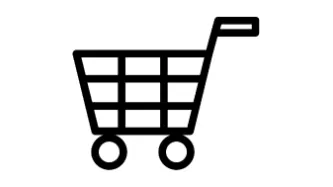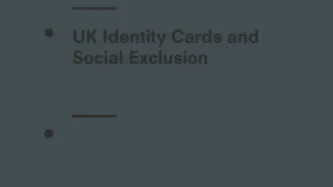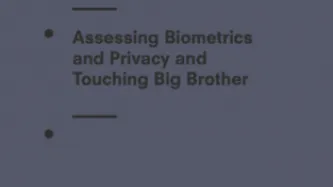Search
Content type: Examples
While not currently mandatory to access healthcare services, Aadhaar is however increasingly used in the health sector as well. In 2018, the health ministry had to issue a statement to clarify that Aadhaar was “desirable” but not a must to access a 5 rupee insurance cover for hospitalisation under the Ayushman Bharat scheme.
https://www.hindustantimes.com/india-news/aadhaar-desirable-not-must-for-rs-5-lakh-healthcare-scheme-says-centre/story-mvQwqSKzDFYE0rhxqLFbLO.html
Author: Rhythma Kaul…
Content type: Examples
In this review of Virginia Eubanks's book Automating Inequality, the author of the review looks at the three main case studies Eubanks explores in her book: the attempt to automate and privatise the welfare system elligibility management in the state of Indiana in 2006, the use of a coordinated entry system in Los Angeles County to address homelessness and the Allegheny Family Screening Tool that attempts to predict child abuse in Pennsylvania. He focuses in particular on Indiana, a state that…
Content type: Examples
In this 2013 piece, Virginia Eubanks discuss the move in Indiana from relying on caseworkers to automating the distribution of benefits and how through the use of performance metrics to speed up the decision-making process, the system ended up being incentivising the non-distribution of benefits.
https://virginia-eubanks.com/2013/12/11/caseworkers-vs-computers/
Author: Virginia Eubanks
Publication: virginia-eubanks.com
Content type: Examples
In this interview (podcast and transcript) Virginia Eubanks discuss three case studies from her book Automating Inequality to illustrate how technology and data collection negatively impact people in vulnerable situation.
The (failed) attempt to automate and privatise the welfare system elligibility management in the state of Indiana in 2006.
The use of a coordinated entry system in Los Angeles County to address homelessness.
The Allegheny Family Screening Tool that attempts to…
Content type: Examples
In the United States, monitoring efforts to combat public benefits fraud are often part of a broader approach that focuses on stigmatizing people receiving benefits and reducing their number, rather than ensuring that the maximum number of people who are eligible receive benefits. However, fraud constitutes less than 1% of the benefits disbursed through the Supplemental Nutrition Assistance Program (SNAP), which are also known as food stamps, and less than 2% of unemployment insurance payments…
Content type: Examples
In the United States, while everyone is surveilled not every is equal when it comes to surveillance. Factors including poverty, race, religion, ethnicity, and immigration status will affect how much you end up being surveilled. This reality has a punitive effect on poor people and their families and places disproportionate burdens on people of minority groups.
https://tcf.org/content/report/disparate-impact-surveillance/?agreed=1
Author: Barton Gellman and Sam Adler-Bell
Publication: The…
Content type: Examples
The vast majority of public benefits programs in the United States—Supplemental Security Income, Temporary Assistance for Needy Families, Medicaid, Children’s Health Insurance Program, Supplemental Nutrition Assistance Programs, the Earned Income Tax Credit, and Housing Assistance—do not take the form of cash transfers. The Temporary Assistance for Needy Families program provides limited cash transfers to families, and it is dependent on families disclosing extensive personal information to…
Content type: Examples
The first conditional cash transfer program in a higher-income country was trialled in the United States by Mayor Bloomberg in New York City from April 2007 to August 2010. Known as Opportunity NYC-Family Rewards, the privately funded pilot program transferred cash rewards to families who were able to meet certain requirements related to children’s education, preventative healthcare, and parents’ employment. Twenty-two different rewards ranged from $20 to $600, and families earned $8,700 on…
Content type: Examples
Virginia Eubanks explains what we can draw from understanding the experience of surveillance of marginalised groups: it is a civil rights issue, technologies carry the bias of those who design them, people are resisting and why we need to move away from the privacy rights discourse.
https://prospect.org/article/want-predict-future-surveillance-ask-poor-communities
Author: Virginia Eubanks
Publication: The American Prospect
Content type: Examples
In this interview with Virginia Eubanks, the author highlights how electronic benefit transfer cards have become tracking devices and how data exploitation used to restrict access to welfare.
https://www.vox.com/2018/2/6/16874782/welfare-big-data-technology-poverty
Author: Sean Illing
Publication: Vox
Content type: Examples
This article is an overview of some of the research documenting how people in vulnerable positions are the ones most affected by government surveillance.
https://stateofopportunity.michiganradio.org/post/technology-opportunity-researcher-says-surveillance-separate-and-unequal
Author: Kimberly Springer
Publication: State of Opportunity Michigan Radio
Content type: Examples
For US citizens who can access benefits, many states use electronic benefit transfer (EBT) cards, which function like debit cards, to distribute benefits. As of 2015, at least 37 states issued Temporary Assistance to Needy Families benefits, also known as welfare, through EBT cards.
http://www.ncsl.org/research/human-services/ebt-electronic-benefit-transfer-card-restrictions-for-public-assistance.aspx
Publication: National Conference of State Legislatures
Content type: Examples
In 2016, researchers discovered that the personalisation built into online advertising platforms such as Facebook is making it easy to invisibly bypass anti-discrimination laws regarding housing and employment. Under the US Fair Housing Act, it would be illegal for ads to explicitly state a preference based on race, colour, religion, gender, disability, or familial status. Despite this, some policies - such as giving preference to people who already this - work to ensure that white…
Content type: Examples
A 2017 research report found that the most vulnerable smartphone users are the ones whose devices are most open to fraud and harassment. Cheaper, low-end devices are less secure to begin with, and they are also less often replaced than their more expensive counterparts made by. Apple and Google. At any given time there are millions of Android devices that are open to known exploits. Worse, the poorer population that owns these phones are more likely to use them as their sole means of accessing…
Content type: News & Analysis
Below is the introduction to Privacy International's 2017 International Women's Day report, which highlights the recent work of the PI Network on privacy, surveillance, and gender.
Many of the challenges at the intersection of women’s rights and technology as it relates to privacy and surveillance, come down to control. Such challenges have come sharply into focus as societies trend toward surveillance by default and foster data exploitative ecosystem.
And whilst control, in the context of…
Content type: Report
Financial services are changing, with technology being a key driver. It is affecting the nature of financial services, from credit and lending through to insurance, and even the future of money itself.
The field of fintech is where the attention and investment is flowing. Within it, new sources of data are being used by existing institutions and new entrants. They are using new forms of data analysis.
These changes are significant to this sector and the lives of people it serves. This…
Content type: Case Study
Introduction
Online, and increasingly offline, companies gather data about us that determine what advertisements we see; this, in turn, affects the opportunities in our lives. The ads we see online, whether we are invited for a job interview, or whether we qualify for benefits is decided by opaque systems that rely on highly granular data. More often than not, such exploitation of data facilitates and exacerbates already existing inequalities in societies – without us knowing that it occurs.…
Content type: News & Analysis
Privacy International today is proud to announce our new project, Aiding Privacy, which aims to promote the right to privacy and data protection in the development and humanitarian fields. Below is an outline of the issues addressed in our new report released today, Aiding Surveillance.
New technologies hold great potential for the developing world. The problem, however, is that there has been a systematic failure to critically contemplate the potential ill effects of deploying technologies in…
Content type: Report
This report investigates the probable effect of the proposed UK national Identity Card system on people who are marginalised, who suffer social disadvantage or exclusion, and those who are disabled. The work focuses on the biometrics element of the government’s proposals (specifically facial recognition, ngerprinting and iris scanning).
The Report provides a specific assessment of the recently published biometrics trial conducted by the UK Passport Service (UKPS), and compares these…
Content type: Report
The evolution of information technology is likely to result in intimate interdependence between humans and technology. This fusion has been characterized in popular science fiction as chip implantation. It is, however, more likely to take the form of biometric identification using such technologies as fingerprints, hand geometry and retina scanning.
Some applications of biometric identification technology are now cost-effective, reliable, and highly accurate. As a result, biometric systems are…







